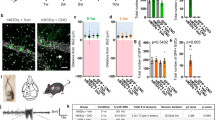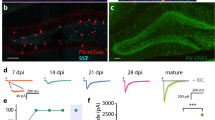Abstract
Depolarization by the neurotransmitter GABA regulates adult neurogenesis. We found interneurons of the neurogliaform cell family to be a primary source of GABA for newborn neurons in mouse dentate gyrus. GABAergic depolarization occurred in concert with reduced synaptic inhibition of mature neurons, suggesting that the local circuitry coordinates the activation of new and pre-existing cells.
This is a preview of subscription content, access via your institution
Access options
Subscribe to this journal
Receive 12 print issues and online access
$209.00 per year
only $17.42 per issue
Buy this article
- Purchase on Springer Link
- Instant access to full article PDF
Prices may be subject to local taxes which are calculated during checkout



Similar content being viewed by others
References
Ge, S. et al. Nature 439, 589–593 (2006).
Markwardt, S.J., Wadiche, J.I. & Overstreet-Wadiche, L.S. J. Neurosci. 29, 15063–15072 (2009).
Espósito, M.S. et al. J. Neurosci. 25, 10074–10086 (2005).
Tamás, G., Lorincz, A., Simon, A. & Szabadics, J. Science 299, 1902–1905 (2003).
Price, C.J. et al. J. Neurosci. 25, 6775–6786 (2005).
Fuentealba, P. et al. Neuron 57, 917–929 (2008).
Tricoire, L. et al. J. Neurosci. 30, 2165–2176 (2010).
Armstrong, C., Szabadics, J., Tamas, G. & Soltesz, I. J. Comp. Neurol. 519, 1476–1491 (2011).
Karayannis, T. et al. J. Neurosci. 30, 9898–9909 (2010).
Szabadics, J., Tamas, G. & Soltesz, I. Proc. Natl. Acad. Sci. USA 104, 14831–14836 (2007).
Oláh, S. et al. Nature 461, 1278–1281 (2009).
Michelson, H.B. & Wong, R.K. J. Physiol. (Lond.) 477, 35–45 (1994).
Oláh, S. et al. Front. Neural Circuits 1, 4 (2007).
Soltesz, I., Smetters, D.K. & Mody, I. Neuron 14, 1273–1283 (1995).
Banks, M.I., White, J.A. & Pearce, R.A. Neuron 25, 449–457 (2000).
Acknowledgements
We thank members of the Wadiche laboratory and A. Tzingounis for helpful comments, and A. Margolies and C. Zhao for technical assistance. This work was supported by grants from the US National Institutes of Health (5T32GM008111, 5R01NS064025 and 2P30NS047466).
Author information
Authors and Affiliations
Contributions
All of the authors contributed to each aspect of this work.
Corresponding author
Ethics declarations
Competing interests
The authors declare no competing financial interests.
Supplementary information
Supplementary Text and Figures
Supplementary Figures 1–8, Supplementary Table 1 and Supplementary Methods (PDF 6892 kb)
Rights and permissions
About this article
Cite this article
Markwardt, S., Dieni, C., Wadiche, J. et al. Ivy/neurogliaform interneurons coordinate activity in the neurogenic niche. Nat Neurosci 14, 1407–1409 (2011). https://doi.org/10.1038/nn.2935
Received:
Accepted:
Published:
Issue Date:
DOI: https://doi.org/10.1038/nn.2935
This article is cited by
-
Recruitment of parvalbumin and somatostatin interneuron inputs to adult born dentate granule neurons
Scientific Reports (2020)
-
Activating newborn neurons suppresses depression and anxiety-like behaviors
Nature Communications (2019)
-
Critical periods regulating the circuit integration of adult-born hippocampal neurons
Cell and Tissue Research (2018)
-
Neural mechanisms underlying GABAergic regulation of adult hippocampal neurogenesis
Cell and Tissue Research (2018)
-
Bidirectional GABAergic control of action potential firing in newborn hippocampal granule cells
Nature Neuroscience (2016)



